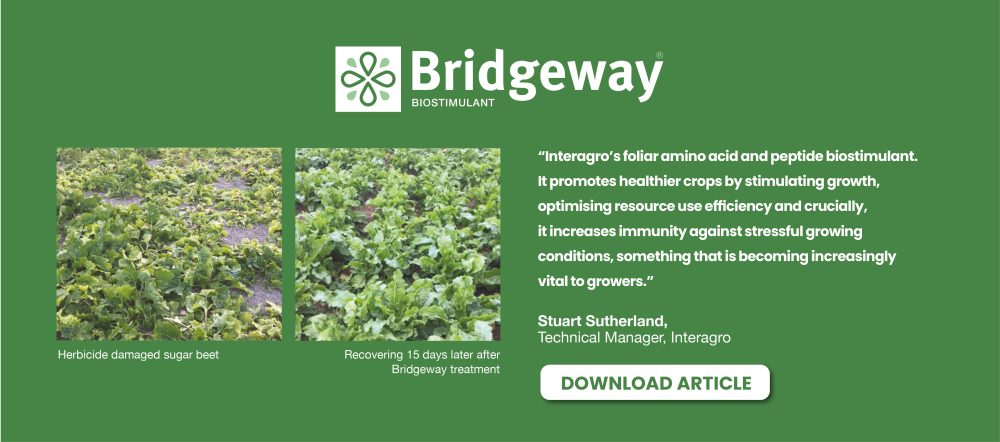Nutrient stress, temperature stress, drought and disease all have the potential to threaten crop performance, but incorporating biostimulants into crop management programmes through the season can help minimise crop stress to safeguard yield and protect profitability.
Biostimulants are substances or microorganisms that, when applied to plants or the soil, promote plant growth and enhance crop yield by improving nutrient uptake, stress tolerance, and overall plant health.
This spring repair, recharge and building resilience are the key objectives for growers seeking to recover plant health in winter crops to prevent a further slide in yield potential. In spring crops – if the last few years are anything to go by – optimising establishment and preparing crops to cope with dry conditions as the season develops, will be crucial.
“Keeping crops stress-free with biostimulants during the growing season involves strategic application and timing,” says Stuart Sutherland, technical manager at Interagro.
Here are some general guidelines on how farmers can use biostimulants to mitigate stress as the season progresses.
Considerations
- Identify likely stress factors
- Biostimulants should compliment other inputs
- Timing of application is key
- Choose proven reputable biostimulant products
- Monitor, evaluate and adapt
UTILISING BIOSTIMULANTS IN WINTER AND SPRING CROPS
Step 1 – Identify likely stress factors
The first step is to identify the specific stress factors that are likely to affect crops, both now and as the season develops – such as cold soils, nutrient depleted soils, potential drought periods, heat stress.

Step 2 – Biostimulants should compliment other inputs
How much importance are you placing on the plant’s own defence system? Consider your fertiliser and crop protection strategies– if you are aiming to reduce reliance on them this season then you’ll need to put greater emphasis on building plant health with nutrition and biostimulants early in the growing cycle to produce more resilient crops.
Step 3 – Timing of application is key
It’s vital you consider timing in relation to the stress factors likely to impact the crop, the weak spots in your fertiliser and crop protection strategies, and when your biostimulant application is most likely to mitigate against the potential threats.

Seed treatment is the best time to protect potential
Consider biostimulant seed treatment in spring crops to optimise establishment.
Low soil temperatures and also low energy reserves caused by poor nutrition in the previous crop can all delay seedling germination and emergence, leading to poor crop vigour. The exposure of seeds to abiotic stress can also result in lower seed viability, reduced germination and poor seedling establishment that will lead to poor growth and compromise yield and quality potential down the road.
Biostimulants applied to the seed can promote better seed germination and establishment of young plants, setting a stronger foundation for the entire crop cycle. Stimulating plants to root should also be a primary objective in spring crops as early access to nutrition and moisture is not only critical for the healthy and rapid development of the crop, it will also create a moreself-sufficient crop that is better able to tolerate drought periods as the season unfolds. With deeper roots, crops will also be better placed to scavenge for essential nutrients.
This spring soil and ambient temperatures are far from ideal, and plantings delayed. It’s worth considering a well-rounded seed treatment biostimulant such as Newton, that can stimulate plants to thrive from day one.
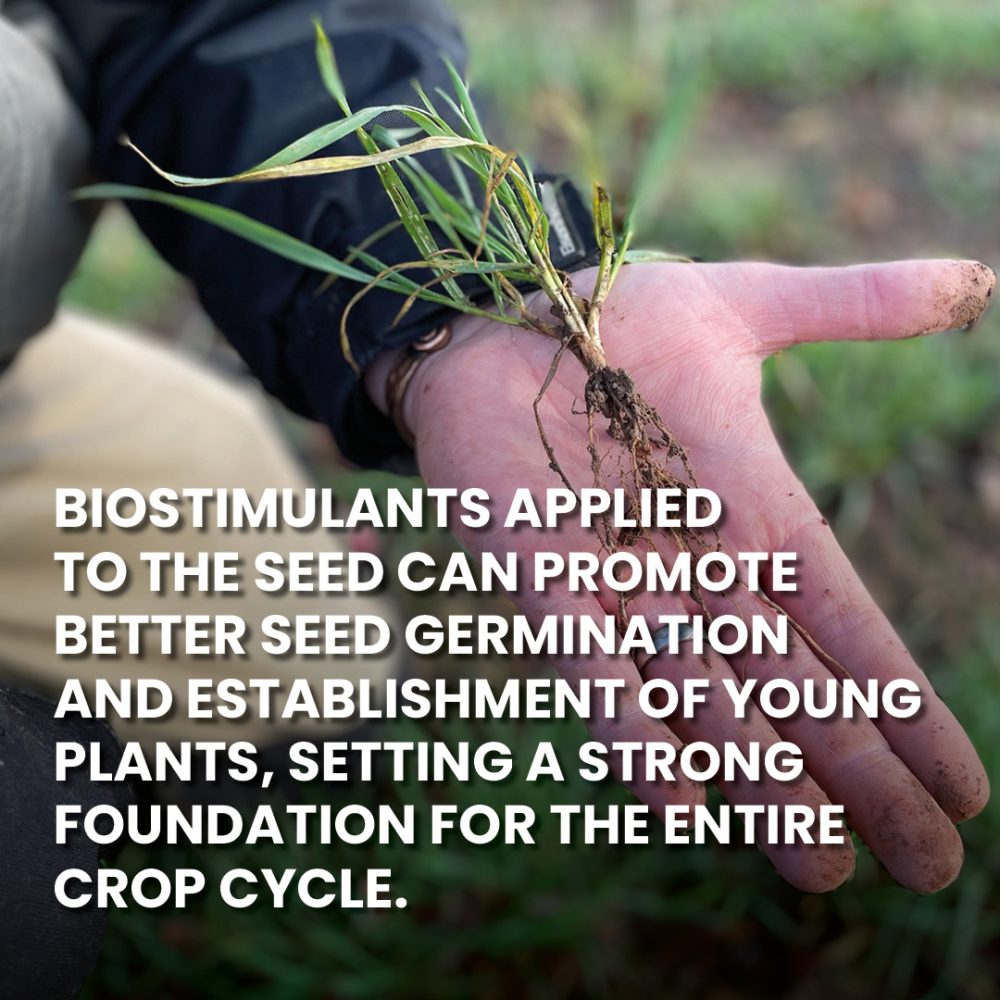
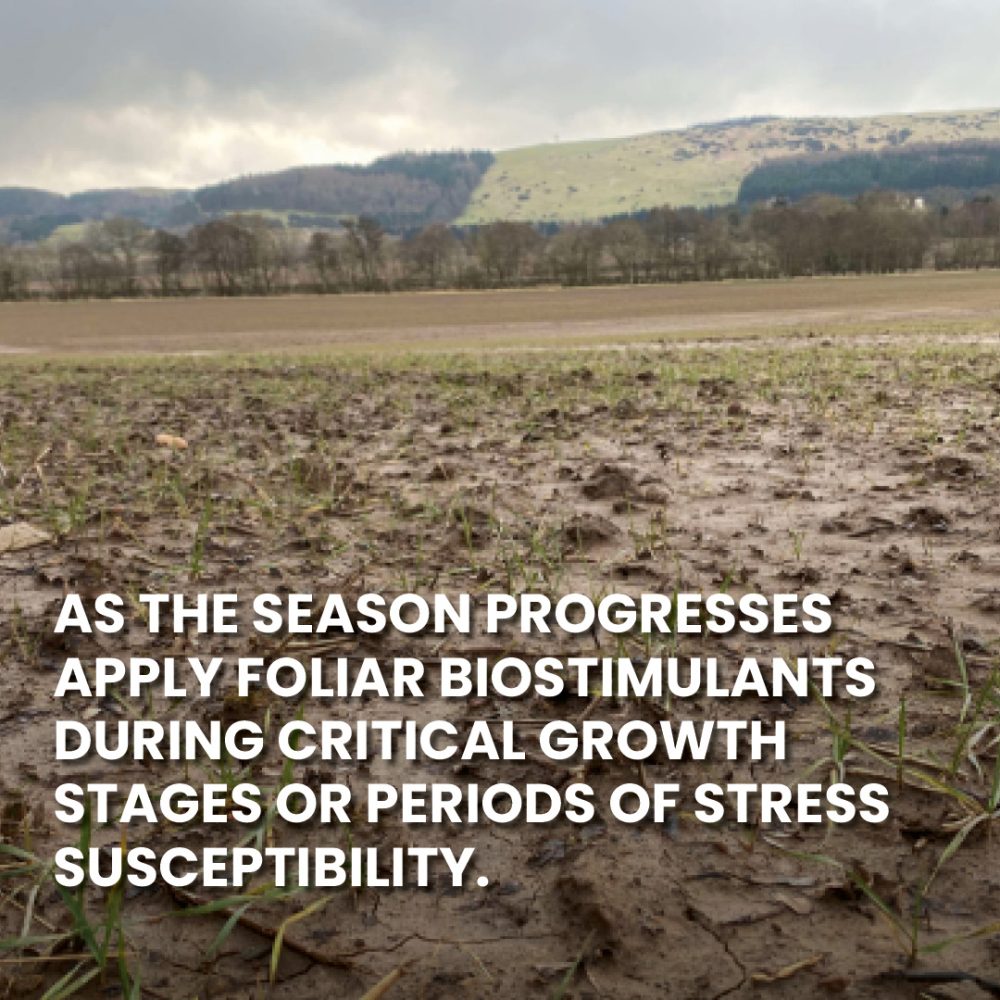
Apply foliar biostimulants strategically
As the season progresses apply foliar biostimulants during critical growth stages or periods of stress susceptibility.
If you are looking to reduce reliance on crop protection inputs, then early application can also help prime the plant’s defense mechanisms before stress occurs.
After the record-breaking wet conditions this year so far, rebuilding plant health in winter crops is crucial to help safeguard remaining yield potential.
Foliar biostimulants in cereals
Rooting is the lifeline to the plant and will be crucial to help crops tolerate a drought. This season in particular, applying a proven biostimulant known to boost rooting, is advisable to help recover rooting in winter crops and support nutrient uptake – deficiency stress makes the plant much more sensitive and vulnerable to pathogen attacks.
If we’re thinking about disease prevention in wheat, T0 is a key time to start supporting your plant’s own defence system.
In barley, ramularia is triggered by stressful growing conditions early season. Environmental stresses such as waterlogging, high light intensity and drought can all exacerbate the disease. Applying a biostimulant such as Bridgeway around T1 to T1.5 – to prevent these stress factors, can all help reduce the triggers for the disease.
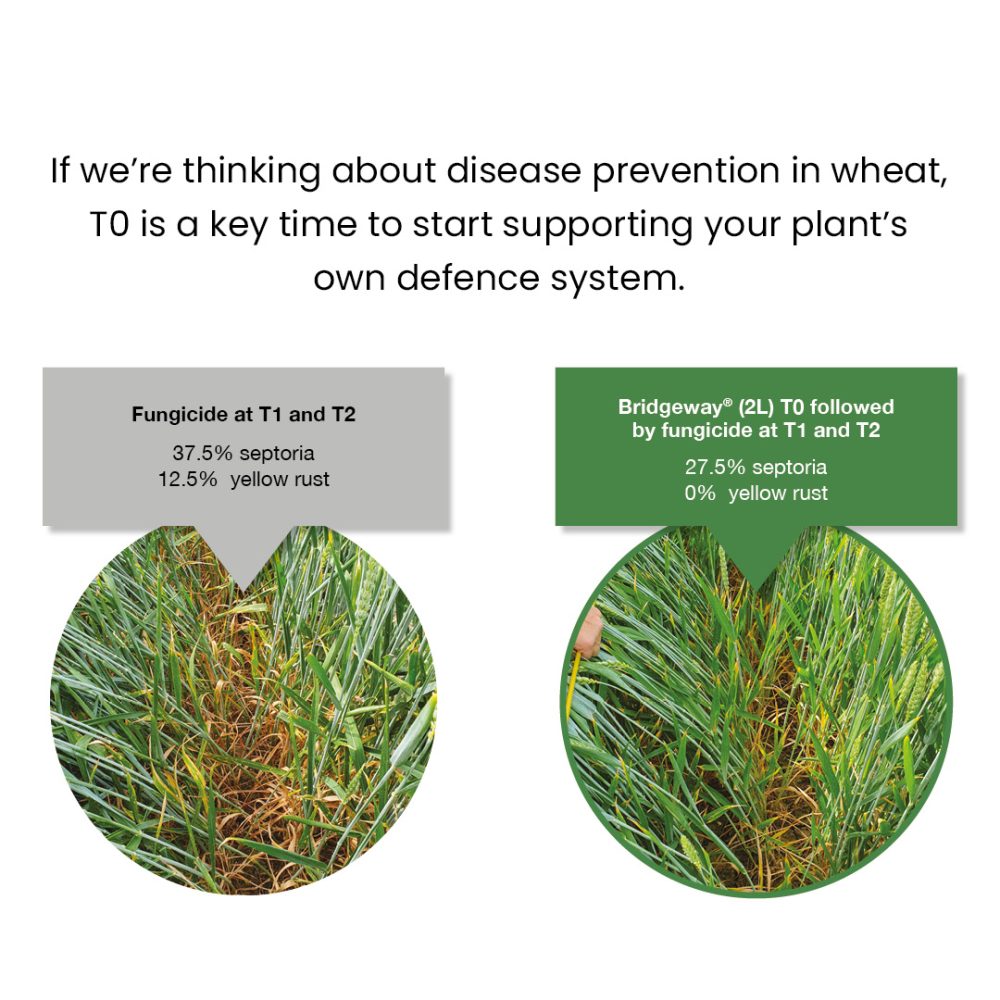
Above: Bridgeway helping reduce disease incidence in a wet year. Disease infection in winter wheat, leaf 3. Source: Agrisource New Zealand / Fieldtek Research, 2023. Fungicide programme was T1: Prosaro 1 + Folpet 1.5 T2: Elatus Plus (benzovindiflupyr) + Opus.
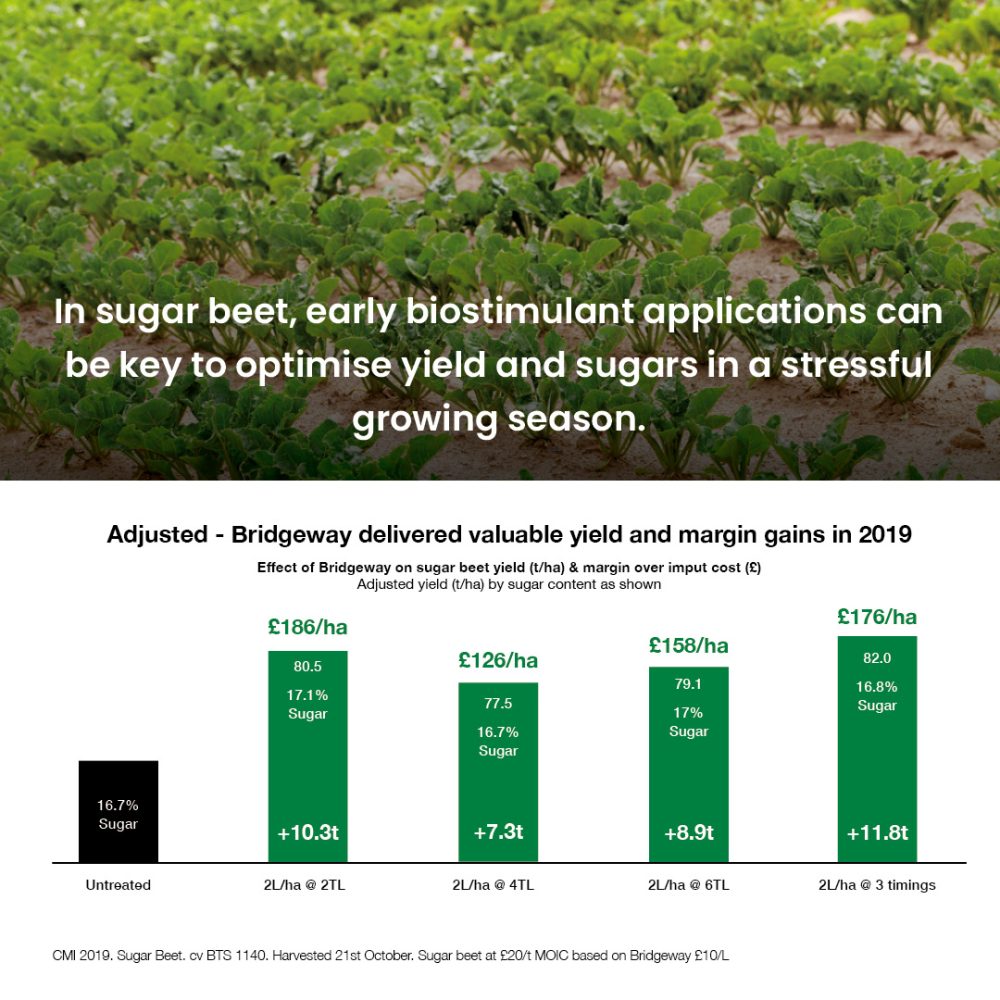
Foliar biostimulants in sugar beet
High yields come from producing a full leaf canopy that intercepts 90% of incoming sunlight as quickly as possible and maintains its greeness right through the growing season.
Sugar beet is particularly sensitive to abiotic stress, which decreases photosynthesis, canopy expansion, root growth and sucrose accumulations.
Bridgeway biostimulant applications from 2-4 true leaves to eliminate temperature stress, stimulate growth and provide an energy boost to crops, can have a significant impact on crop yield and sugars.
Foliar biostimulants in potatoes
Keeping potatoes stress-free is not an easy task, with crops often subjected to prolonged heat stress periods at key growth timings.
Potato potential including the number of progeny tubers and the rate of tuber bulking is established early in the season at about the time tubers reach 10mm in size. Stressful growing conditions during this time can therefore have a big influence on crop yield.
Once tuber bulking has started, the rate cannot be increased but can be reduced or interrupted by stress. The earlier in the season heat stress occurs, the more negative its impact on the growth and yield.
Every 5ºC increase above the optimum temperature of 20ºC can decrease the rate of photosynthesis by 25%. Potatoes start to suffer from high temperature stress as temperatures exceed 25ºC, when the rate of photosynthesis begins to decline, significantly reducing the partitioning of sucrose translocation to tubers. Heat stress can therefore reduce the rate of bulking, at 30ºC it can pause it altogether as the rate of energy used by respiration to keep cool, exceeds the rate at which energy is produced by photosynthesis.
Bridgeway applications applied at the onset of bulking have the greatest potential to mitigate the effects of stress on the crop’s bulking and yield potential.

Application to veg crops
With the loss of chemistry and fewer solutions in the speciality crops stable, keeping veg crops disease, pest and stress free can be tricky. Early biostimulant applications are crucial to optimise seedling health from day one, with multiple early applications often proving beneficial. Using a proven biostimulant such as Bridgeway, to build plant health ahead of stress periods during the season can be crucial to prevent damage to crops. Timing applications ahead of stress will help prepare crops to crop better.

Step 4 – Choose proven reputable biostimulant products

Prepare crops with Bridgeway
One biostimulant that has been put through its paces over the years and shown it can tick the boxes on these plant health objectives is Interagro’s amino acid based biostimulant Bridgeway. It’s the extraordinary stress recovery and resilience benefits – seen in trials and on farm – that make Bridgeway stand out.
Step 5 – Monitor, evaluate and adapt
Regularly monitor crop performance and assess the impact of biostimulant application against untreated controls.
On-farm trials are a good way to compare product performance on your soils, in your climatic conditions and within your wider inputs plan.
Keep in mind that biostimulants can also be used to bring weaker parts of the field up in terms of performance, and here, large tramline trials are a good way of assessing the benefits versus untreated.
Flexibility and adaptation are essential for optimising the effectiveness of foliar biostimulants in managing crop stress. Adjust application timing and rates based on changing environmental conditions or crop growth stages throughout the growing season. Try to anticipate stress periods and apply your biostimulant in good time. If its not possible to apply ahead of time, apply your biostimulant as soon as possible after the stress event has occurred to support crop recovery.
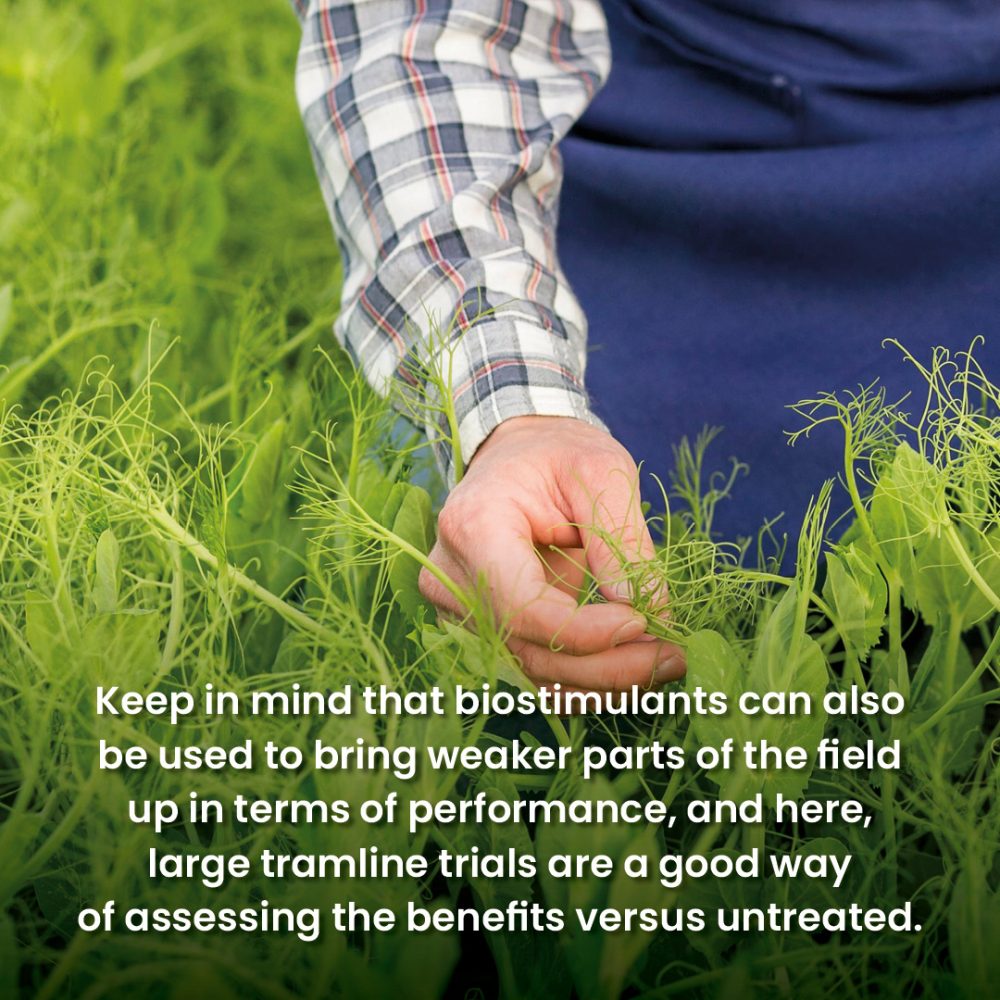
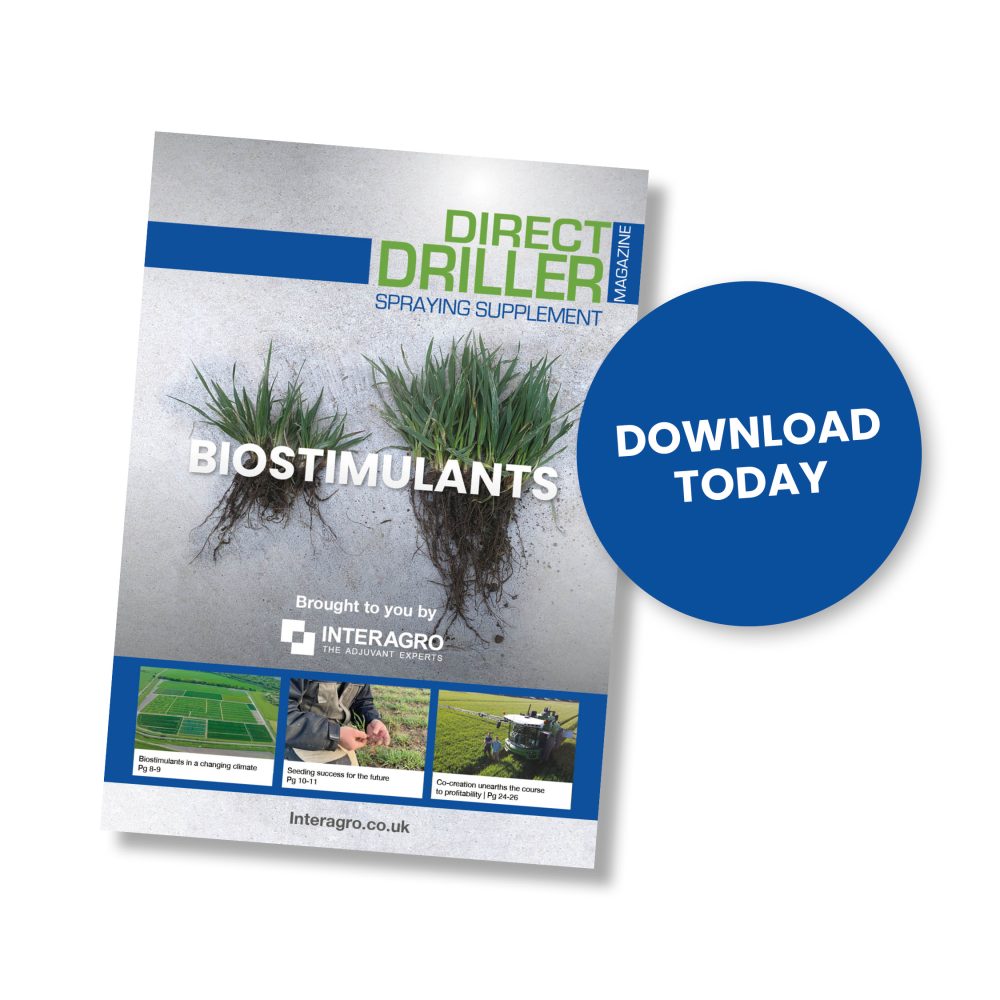
Download our new Biostimulant Magazine for a deeper dive
More and more farmers are considering plant biostimulants in a quest to make their farming systems more resilient and sustainable. We’ve brought our biostimulant knowledge and know-how to bare in our new Biostimulants Magazine. You can download the full magazine here.
Get in touch
For any technical questions and to talk through how our biostimulant solutions could help minimise crop stress in your crops this season, please contact our technical manager, Stuart Sutherland, below.






